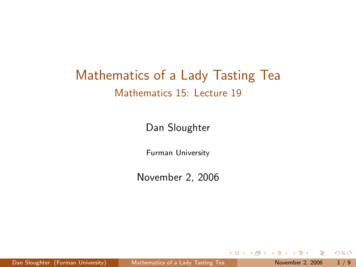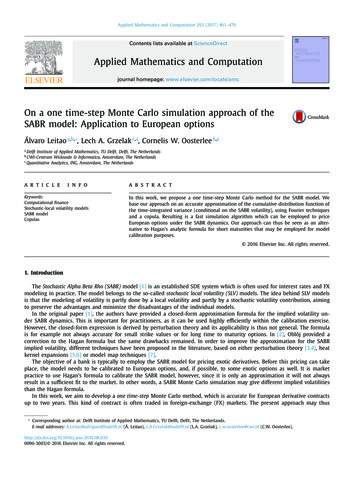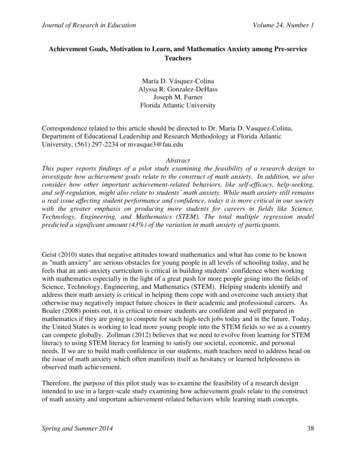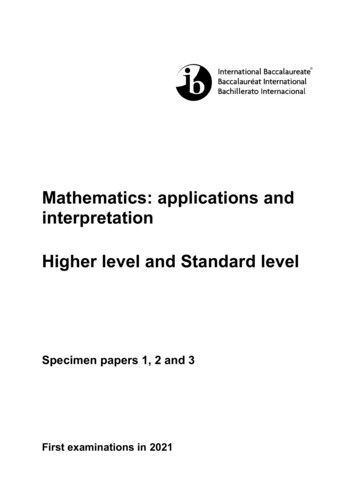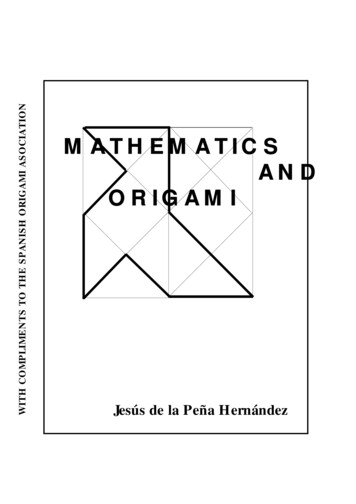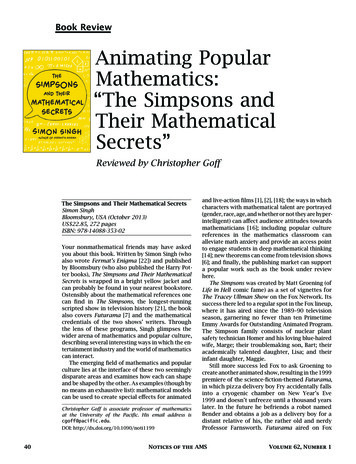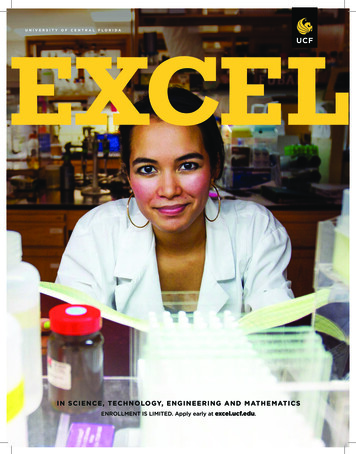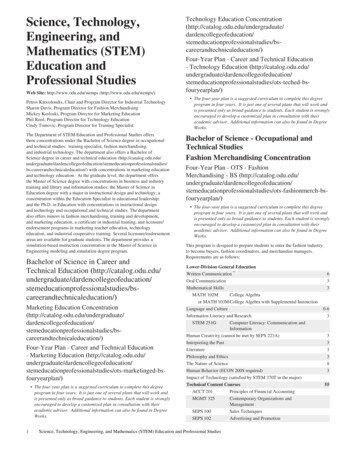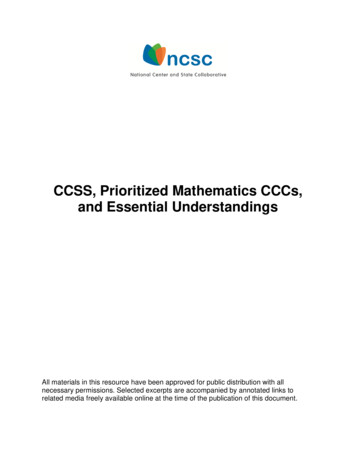
Transcription
CCSS, Prioritized Mathematics CCCs,and Essential UnderstandingsAll materials in this resource have been approved for public distribution with allnecessary permissions. Selected excerpts are accompanied by annotated links torelated media freely available online at the time of the publication of this document.
The National Center and State Collaborative (NCSC) is applying the lessons learnedfrom the past decade of research on alternate assessments based on alternateachievement standards (AA-AAS) to develop a multi-state comprehensive assessmentsystem for students with significant cognitive disabilities. The project draws on a strongresearch base to develop an AA-AAS that is built from the ground up on powerfulvalidity arguments linked to clear learning outcomes and defensible assessment results,to complement the work of the Race to the Top Common State Assessment Program(RTTA) consortia.Our long-term goal is to ensure that students with significant cognitive disabilitiesachieve increasingly higher academic outcomes and leave high school ready for postsecondary options. A well-designed summative assessment alone is insufficient toachieve that goal. Thus, NCSC is developing a full system intended to supporteducators, which includes formative assessment tools and strategies, professionaldevelopment on appropriate interim uses of data for progress monitoring, andmanagement systems to ease the burdens of administration and documentation. Allpartners share a commitment to the research-to-practice focus of the project and thedevelopment of a comprehensive model of curriculum, instruction, assessment, andsupportive professional development. These supports will improve the alignment of theentire system and strengthen the validity of inferences of the system of assessments.The contents of this lesson were developed as part of the NationalCenter and State Collaborative under a grant from the Department ofEducation (PR/Award #: H373X100002, Project Officer,Susan.Weigert@Ed.gov). However, the contents do not necessarilyrepresent the policy of the U.S. Department of Education and noassumption of endorsement by the Federal government should bemade.The University of Minnesota is committed to the policy that all persons shall have equalaccess to its programs, facilities, and employment without regard to race, color, creed,religion, national origin, sex, age, marital status, disability, public assistance status,veteran status, or sexual orientation.These materials and documents were developed under the National Center and StateCollaborative (NCSC) General Supervision Enhancement Grant and are consistent withits goals and foundations. Any changes to these materials are to be consistent with theirintended purpose and use as defined by NCSC.This document is available in alternative formats upon request.
NCSC is a collaborative of 14 states and five organizations.The states include (shown in blue on map): Arizona, Connecticut, District of Columbia,Florida, Georgia, Indiana, Louisiana, Pacific Assessment Consortium (PAC-6)1,Pennsylvania, Rhode Island, South Carolina, South Dakota, Tennessee, and Wyoming.Tier II states are partners in curriculum, instruction, and professional developmentimplementation but are not part of the assessment development work. They are (shownin orange on map): Arkansas, California, Delaware, Idaho, Maine, Maryland, Montana,New Mexico, New York, Oregon, and U.S. Virgin Islands.1The Pacific Assessment Consortium (including the entities of American Samoa,Commonwealth of the Northern Mariana Islands, Federated States of Micronesia, Guam,Republic of Palau, and Republic of the Marshall Islands) partner with NCSC as one state, led bythe University of Guam Center for Excellence in Developmental Disabilities Education,Research, and Service (CEDDERS).
The five partner organizations include: The National Center on Educational Outcomes(NCEO) at the University of Minnesota, The National Center for the Improvement ofEducational Assessment (Center for Assessment), The University of North Carolina atCharlotte, The University of Kentucky, and edCount, LLC.150 Pillsbury Drive SE207 Pattee HallMinneapolis, MN 55455Phone: 612-708-6960Fax: 612-624-0879www.ncscpartners.org
CCSS, Prioritized Mathematics CCCs,and Essential UnderstandingsJanuary 2014
Table of ContentsNCSC CCSS, Prioritized Mathematics CCCs, and EUs for Grade 3 . 6NCSC CCSS, Prioritized Mathematics CCCs, and EUs for Grade 4 . 9NCSC CCSS, Prioritized Mathematics CCCs, and EUs for Grade 5 . 13NCSC CCSS, Prioritized Mathematics CCCs, and EUs for Grade 6 . 17NCSC CCSS, Prioritized Mathematics CCCs, and EUs for Grade 7 . 22NCSC CCSS, Prioritized Mathematics CCCs, and EUs for Grade 8 . 25NCSC CCSS, Prioritized Mathematics CCCs, and EUs for High School . 29CCSS, Prioritized Mathematics CCCs, and EUs, January 20145
National Center State Collaborative CCSS, Prioritized Mathematics CCCs, andEssential UnderstandingsNCSC CCSS, Prioritized Mathematics CCCs, and EUs for Grade 3DomainOperations &AlgebraicThinkingOperations &AlgebraicThinkingOperations &AlgebraicThinkingCCSS3.OA.A.1 Interpret products ofwhole numbers, e.g., interpret 5 7as the total number of objects in 5groups of 7 objects each. Forexample, describe a context inwhich a total number of objects canbe expressed as 5 7.3.OA.D.8 Solve two-step wordproblems using the four operations.Represent these problems usingequations with a letter standing forthe unknown quantity. Assess thereasonableness of answers usingmental computation and estimationstrategies including rounding.3.OA.D.9 Identify arithmetic patterns(including patterns in the additiontable or multiplication table), andexplain them using properties ofoperations. For example, observethat 4 times a number is alwayseven, and explain why 4 times anumber can be decomposed intotwo equal addends.CCCEssential Understandings3.NO.2d3 Solve multiplicationproblems with neither numbergreater than 5.Create an array of sets (e.g., 3 rowsof 2).3.NO.2e1 Solve or solve and checkone or two-step word problemsrequiring addition, subtraction ormultiplication with answers up to100.Combine ( ), decompose (-), andmultiply (x) with concrete objects;use counting to get the answers.Match the action of combining withvocabulary (i.e., in all; altogether) orthe action of decomposing withvocabulary (i.e., have left; takeaway) in a word problem.Concrete understanding of a patternas a set that repeats regularly orgrows according to a rule; Ability toidentify a pattern that grows (able toshow a pattern) (shapes, symbols,objects).3.PRF.2d1 Identify multiplicationpatterns in a real world setting.CCSS, Prioritized Mathematics CCCs, and EUs, January 20146
DomainNumber &Operations inBase TenNumber &Operations inBase TenNumber &Operations—FractionsNumber &Operations—FractionsCCSSCCC3.NBT.A.1 Use place valueunderstanding to round wholenumbers to the nearest 10 or 100.3.NO.1j3 Use place value to roundto the nearest 10 or 100.3.NBT.A.2 Fluently add andsubtract within 1000 using strategiesand algorithms based on placevalue, properties of operations,and/or the relationship betweenaddition and subtraction.3.NF.A.1 Understand a fraction 1/bas the quantity formed by 1 partwhen a whole is partitioned into bequal parts; understand a fractiona/b as the quantity formed by aparts of size 1/b.3.NF.A.3d Compare two fractionswith the same numerator or thesame denominator by reasoningabout their size. Recognize thatcomparisons are valid only when thetwo fractions refer to the samewhole. Record the results ofcomparisons with the symbols , ,or , and justify the conclusions,e.g., by using a visual fractionmodel.3.NO.2c1 Solve multi-step additionand subtraction problems up to 100.Essential UnderstandingsIdentify ones or tens in bundled sets– Similar/different with concreterepresentations (i.e., is this set ofmanipulatives (8 ones) closer to thisset (a ten) or this set (a one)?).Combine ( ) or decompose (-) withconcrete objects; use counting toget the answers.3.NO.1l3 Identify the fraction thatmatches the representation(rectangles and circles; halves,fourths, and thirds, eighths).Identify part and whole when item isdivided. Count the number of theparts selected (3 of the 4 parts;have fraction present but notrequired to read ¾).3.SE.1g1 Use , , or to comparetwo fractions with the samenumerator or denominator.Concrete representation of afractional part of a whole as greaterthan, less than, equal to another.CCSS, Prioritized Mathematics CCCs, and EUs, January 20147
DomainMeasurement &DataMeasurement &DataGeometryCCSS3.MD.B.3 Draw a scaled picturegraph and a scaled bar graph torepresent a data set with severalcategories. Solve one- and two-step“how many more” and “how manyless” problems using informationpresented in scaled bar graphs. Forexample, draw a bar graph in whicheach square in the bar graph mightrepresent 5 pets.3.MD.C.6 Measure areas bycounting unit squares (square cm,square m, square in, square ft, andimprovised units).3.G.A.2 Partition shapes into partswith equal areas. Express the areaof each part as a unit fraction of thewhole. For example, partition ashape into 4 parts with equal area,and describe the area of each partas 1/4 of the area of the shape.CCCEssential Understandings3.DPS.1g1 Collect data, organizeinto picture or bar graph.Organize data into a graph usingobjects (may have numbersymbols).3.ME.1d2 Measure area ofrectangular figures by countingsquares.Ability to identify the area of arectangular figure.3.GM.1i1 Partition rectangles intoequal parts with equal area.Concept of equal parts; Partitioningwith concrete objects; Find therectangle that is the same or matchtwo congruent rectangles.CCSS, Prioritized Mathematics CCCs, and EUs, January 20148
NCSC CCSS, Prioritized Mathematics CCCs, and EUs for Grade 4DomainOperations &AlgebraicThinkingOperations &AlgebraicThinkingOperations &AlgebraicThinkingCCSSCCCsEssential Understandings4.OA.A.1 Interpret a multiplicationequation as a comparison, e.g.,interpret 35 5 7 as a statementthat 35 is 5 times as many as 7 and7 times as many as 5. Representverbal statements of multiplicativecomparisons as multiplicationequations.4.OA.A.2 Multiply or divide to solveword problems involvingmultiplicative comparison, e.g., byusing drawings and equations with asymbol for the unknown number torepresent the problem,distinguishing multiplicativecomparison from additivecomparison.4.OA.A.3 Solve multistep wordproblems posed with wholenumbers and having whole-numberanswers using the four operations,including problems in whichremainders must be interpreted.Represent these problems usingequations with a letter standing forthe unknown quantity. Assess thereasonableness of answers usingmental computation and estimationstrategies including rounding.4.NO.2d7 Determine how manyobjects go into each group whengiven the total number of objects andgroups where the number in eachgroup or number of groups is not 10.Create an array of objects given aspecific number of rows and the totalnumber, place one object in eachgroup/row at a time.4.PRF.1e3 Solve multiplicativecomparisons with an unknown usingup to 2-digit numbers withinformation presented in a graph orword problem (e.g., an orange hatcost 3. A purple hat cost 2 times asmuch. How much does the purple hatcost? [3 x 2 p]).Identify visual multiplicativecomparisons (e.g., which shows twotimes as many tiles as this set?).4.NO.2e2 Solve or solve and checkone or two step word problemsrequiring addition, subtraction, ormultiplication with answers up to 100.Select the representation ofmanipulatives on a graphic organizerto show addition/multiplicationequation; Match to same forrepresentations of equations withequations provided (may be differentobjects but same configuration).CCSS, Prioritized Mathematics CCCs, and EUs, January 20149
DomainNumber &Operations inBase TenNumber &Operations—FractionsNumber &Operations—FractionsCCSSCCCsEssential Understandings4.NBT.A.3 Use place valueunderstanding to round multi-digitwhole numbers to any place.4.NO.1j5 Use place value to round toany place (i.e., ones, tens, hundreds,thousands).4.NF.A.1 Explain why a fraction a/bis equivalent to a fraction (n a)/(n b) by using visual fraction models,with attention to how the numberand size of the parts differ eventhough the two fractions themselvesare the same size. Use this principleto recognize and generateequivalent fractions.4.NF.A.2 Compare two fractionswith different numerators anddifferent denominators, e.g., bycreating common denominators ornumerators, or by comparing to abenchmark fraction such as 1/2.Recognize that comparisons arevalid only when the two fractionsrefer to the same whole. Record theresults of comparisons with symbols , , or , and justify theconclusions, e.g., by using a visualfraction model.4.NO.1m1 Determine equivalentfractions.Identify ones, tens, hundreds inbundled sets – Similar/different withconcrete representations (i.e., is thisset of manipulatives (8 tens) closer tothis set (a hundred) or this set (aten)?).Equivalency: what is and what is notequivalent; this may begin withnumbers/sets of objects: e.g., 3 3 ortwo fraction representations that areidentical (two pies showing 2/3).4.NO.1n2 Compare up to 2 givenfractions that have differentdenominators.CCSS, Prioritized Mathematics CCCs, and EUs, January 2014Differentiate between parts and awhole.10
DomainNumber &Operations—FractionsMeasurement &DataMeasurement &DataCCSSCCCsEssential Understandings4.NF.A.2 Compare two fractionswith different numerators anddifferent denominators, e.g., bycreating common denominators ornumerators, or by comparing to abenchmark fraction such as 1/2.Recognize that comparisons arevalid only when the two fractionsrefer to the same whole. Record theresults of comparisons with symbols , , or , and justify theconclusions, e.g., by using a visualfraction model.4.MD.A.3 Apply the area andperimeter formulas for rectangles inreal world and mathematicalproblems. For example, find thewidth of a rectangular room giventhe area of the flooring and thelength, by viewing the area formulaas a multiplication equation with anunknown factor.4.MD.B.4 Make a line plot to displaya data set of measurements infractions of a unit (1/2, 1/4, 1/8).Solve problems involving additionand subtraction of fractions by usinginformation presented in line plots.For example, from a line plot findand interpret the difference in lengthbetween the longest and shortestspecimens in an insect collection.4.SE.1g2 Use , , or to compare 2fractions (fractions with a denominatorof 10 or less).Concrete representation of afractional part of a whole as greaterthan, less than, equal to another.4.ME.1g2 Solve word problems usingperimeter and area where changesoccur to the dimensions of arectilinear figure.Identify the perimeter; Identify thearea; Show each when size of figurechanges.4.DPS.1g3 Collect data, organize inIdentify data set based on a singlegraph (e.g. picture graph, line plot, bar attribute (e.g., pencils vs. markers);graph).Identify data set with more or less(e.g., this bar represents a set withmore); Organize the data into a graphusing objects (may have numbersymbols).CCSS, Prioritized Mathematics CCCs, and EUs, January 201411
DomainCCSSGeometry4.G.A.2 Classify two-dimensionalfigures based on the presence orabsence of parallel or perpendicularlines, or the presence or absence ofangles of a specified size.Recognize right triangles as acategory, and identify right triangles.CCCs4GM.1h2 Classify two-dimensionalshapes based on attributes (# ofangles).CCSS, Prioritized Mathematics CCCs, and EUs, January 2014Essential UnderstandingsIdentify attributes within a 2dimensional figure (e.g., rectangleshave sides – student identifies sidesof rectangle – and angles – studentidentifies angles in rectangle).12
NCSC CCSS, Prioritized Mathematics CCCs, and EUs for Grade 5DomainOperations &AlgebraicThinkingNumber &Operations inBase TenNumber &Operations inBase TenCCSS5.OA.B.3 Generate two numericalpatterns using two given rules.Identify apparent relationshipsbetween corresponding terms. Formordered pairs consisting ofcorresponding terms from the twopatterns, and graph the orderedpairs on a coordinate plane. Forexample, given the rule “Add 3” andthe starting number 0, and given therule “Add 6” and the starting number0, generate terms in the resultingsequences, and observe that theterms in one sequence are twice thecorresponding terms in the othersequence. Explain informally whythis is so.5.NBT.A.3a Read and writedecimals to thousandths usingbase-ten numerals, number names,and expanded form, e.g., 347.392 3 100 4 10 7 1 3 (1/10) 9 (1/100) 2 (1/1000).5.NBT.A.4 Use place valueunderstanding to round decimals toany place.CCCsEssential Understandings5.PRF.2b1 Generate or select acomparison between two graphsfrom a similar situation.Compare two pieces of informationprovided in a single display.5.NO.1b1 Read, write, or select adecimal to the hundredths place.Recognize part whole usingmaterials divided into tenths – Counttenths to determine how many(e.g.,4 tenths) (.4 have the decimalpresent but not required to read).5.NO.1b4 Round decimals to thenext whole number.Identify place value to the ones,tens, hundreds, thousands.CCSS, Prioritized Mathematics CCCs, and EUs, January 201413
DomainNumber &Operations inBase TenNumber &Operations inBase TenNumber &Operations—FractionsCCSSCCCs5.NBT.B.6 Find whole-numberquotients of whole numbers with upto four-digit dividends and two-digitdivisors, using strategies based onplace value, the properties ofoperations, and/or the relationshipbetween multiplication and division.Illustrate and explain the calculationby using equations, rectangulararrays, and/or area models.5.NBT.B.7 Add, subtract, multiply,and divide decimals to hundredths,using concrete models or drawingsand strategies based on placevalue, properties of operations,and/or the relationship betweenaddition and subtraction; relate thestrategy to a written method andexplain the reasoning used.5.NF.A.2 Solve word problemsinvolving addition and subtraction offractions referring to the samewhole, including cases of unlikedenominators, e.g., by using visualfraction models or equations torepresent the problem. Usebenchmark fractions and numbersense of fractions to estimatementally and assess thereasonableness of answers. Forexample, recognize an incorrectresult 2/5 1/2 3/7, by observingthat 3/7 1/2.5.NO.2a5 Solve word problems thatrequire multiplication or division.Combine (x) or decompose ( ) withconcrete objects; use counting toget the answers.5.NO.2c1 Solve 1 step problemsusing decimals.Combine ( ) or decompose (-) withconcrete objects; use counting toget the answers; Match the action ofcombining with vocabulary (i.e., inall; altogether) or the action ofdecomposing with vocabulary (i.e.,have left; take away) in a wordproblem.5.NO.2c2 Solve word problemsinvolving the addition, subtraction,multiplication or division of fractions.Identify what to do with the partswhen given the key word (using thefractional parts).CCSS, Prioritized Mathematics CCCs, and EUs, January 2014Essential Understandings14
DomainNumber &Operations—FractionsMeasurement &DataMeasurement &DataCCSS5.NF.B.5b Explaining whymultiplying a given number by afraction greater than 1 results in aproduct greater than the givennumber (recognizing multiplicationby whole numbers greater than 1 asa familiar case); explaining whymultiplying a given number by afraction less than 1 results in aproduct smaller than the givennumber; and relating the principle offraction equivalence a/b (n a)/(n b) to the effect of multiplying a/bby 1.5.MD.A.1 Convert among differentsized standard
CCSS, Prioritized Mathematics CCCs, and Essential Understandings All materials in this resource have been approved for public distribution with all . Delaware, Idaho, Maine, Maryland, Montana, New Mexico, New York, Oregon, and U.S. Virgin Islands. 1 The Pacific Assessm

